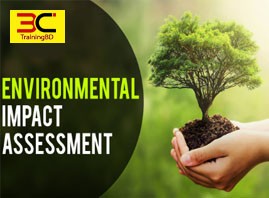If you are one of those who are working on environmental projects or willing to work on such projects in the future, then Environmental Impact Assessment is a crucial term to have knowledge. People initiate plans and policies for developing environmental projects. However, a plan should be perfect, considering its pros and cons. After that, they should actuate the project prior to the proposed plans or policies. Then, there comes Environmental Impact Assessment EIA in short.
You should know, that the term “environmental impact assessment” (EIA) is used by companies or individuals when they actually apply a plan or policy to a real-life project. And those plans, policies, and programs are defined as Strategic Environmental Assessment or SEA in short.
We will discuss more interesting facts on Environmental Impact Assessment. So, stay tuned.
The Definition of Environmental Impact Assessment
In a sentence, Environmental Impact Assessment or EIA is a set of tools used to measure the significant effects of environmental consequences due to the proposed actions of a plan, policy, program, or development proposal on the environment.
According to Chris Wood –
“Environmental Impact Assessment (EIA) is a systematic and integrative process for considering possible impacts prior to a decision being taken on whether or not a proposal should be given the approval to proceed.”
EIA is used to make sure the decision makers of an environmental project are aware of the likely effects on the environment as early as possible. As a result, they can take necessary steps to minimize or avoid those effects. It plays a major role in formatting project approval and decision-making. EIA can be subject to administrative or administrative procedures. It can also be a part of a judicial review.
Table of Contents
ToggleExamples of Environmental Impact Assessment
There is a lot of research regarding environmental impact assessment. As a matter of fact, there are many case studies on environmental impact assessment available online. By going through several case studies, some of them grabbed our attention.
“Project Gramalote Mine TM 14292” is one of them. The Gramalote mining project was proposed in Antioquia, Colombia so that they can develop an open-pit gold mine. There were about 7 million ounces of materials stored in this mine, of which 3,651 million ounces were gold.
So, what was the purpose of this project?
Well, the local, regional and national economy of Colombia will grow largely through this project. On top of that, the construction of this project will stimulate nearly 3,500 direct and 7,000 indirect jobs; which will help in reducing unemployment. More than 25 years took to develop this project and the project was divided into 4 stages. So, this was a prolonged plan.
Another interesting example that we have discovered is the “Technical Reconversion in San Jacinto-Tizate (Nicaragua) to generate 72 MW of electric energy” project. This was a public project developed in 1994. The purpose of this project was to replace existing technology with more efficient ones. By doing so, they successfully amplified the energy generation capacity from 10 MW to 72 MW in Leon, Nicaragua.
And there was also a secondary perspective of this project. The secondary objective was the development of the Kyoto Protocol by increasing the geothermal energy production capacity proposed by the market of Certified Carbon Emissions.
The Process of Environmental Impact Assessment and Its Steps
The process of Environmental Impact Assessment (EIA) may vary. According to the process, a number of steps may be generated. No matter what the process is, the whole process can be divided into 7 steps.
The very first step of the project is to determine whether or not an Environmental Assessment Impact is really needed. Depending on that, a report will be written and submitted for development consent.
There are competent authorities who will decide if the project is suitable for granting consent. Before making a final decision, the authorities go through the information thoroughly. Along with that, they do consider comments from statutory consultees and the public. Therefore, people have a chance to be a part of decision-making.
Figure: Approach to environmental impact assessment
Now, let’s take a look at the following table to know the steps of the process of environmental impact assessment.
| Steps | Description |
| 1. Screening | This is the stage where it determines if an EIA is actually required. |
| 2. Scoping | Here, the authority decides the content needed for making assessments and EIA reports. |
| 3. Evaluating Existing Projects | In this step, they check for any existing project that is the same as the proposed project. They also look for ways to develop alternatives to solve the problem. |
| 4. EIA Report | The EIA report is created and submitted. The report is made based on the likely significant effects of environmental development. |
| 5. Review EIA Report | This is the next stage, where the EIA reports along with development applications must be presented to the public and interested parties so that they can review them and give their opinions. |
| 6. Decision Making | The reviews and comments must be taken into an account by the competent authority before giving the final consent for the development of the project. After that, the decision notice should be published. |
| 7. Post Decision | This is the last step where the developers start to identify any missing requirements in terms of surveillance, compliance, enforcement, and environmental audit. |
Environmental Impact Assessment Report
An Environmental Impact Assessment report compiles the components of the proposed project. These components usually include the description of the project, its effects on the environment, its social impacts, the measurements to mitigate these impacts, related management, monitoring plans, etc.
Now, who usually writes EIA reports?
The proponent of the project is responsible for writing the EIA report. The information contained in the EIA report must meet the terms of reference established during the Scoping phase.
It is not easy to make a comprehensive EIA report. The report must specify a complete identification of the critical impacts. The authority may reject the proposal if the report is described poorly, where the description of the alternatives, mitigation measures, use of outdated assessment models, etc are not sufficient.
Characteristics of an EIA Report
In order to make a quality EIA report, the following characteristics can be considered –
-
- The report should be well structured. It is better to avoid technical languages as much as possible.
-
- It actually describes the whole project and its purpose, providing helpful information that is needed for decision making.
-
- It should contain the adverse effects of the proposed actions as much as possible. It should also describe the mitigation process through conventional and customized techniques.
Environmental Impact Assessment Related Jobs
You can grow a prominent career in the field of environmental impact assessment. If you just search on the internet, you will find tons of job circulars in this sector. You can grow your career as a Global Climate and Environmental Mainstreaming Advisor, Environmental Safeguard Coordinator, Environmental Engineer, Environmental Scientist, Environmental Analyst, Environmental Impact Assessment Practitioner, Environmental Project Coordinator, and so on.
Most of the jobs regarding environmental impact assessment are NGO or governmental types. So, yes; you can expect a lot of facilities along with handsome salaries from such jobs.
Certifications of Environmental Impact Assessment
You can get certified for getting a prominent career in the field of environmental impact assessment. To make yourself competent for a better job or position, these certificates can play a vital role. There are various types of certificates offered by various organizations.
For instance, a person can be a Certified Environmental Impact Assessment Professional (CEIAP) from ISESR. For this, they have to pass an examination with at least 80% marks. The examination will be held for about 3 hours and there are a total of 100 multiple choice questions.
Also, there are certificates for postgraduate-level modules for those who are Continuing Professional Development (CPD). Moreover, there is training on EIA, which is good before finally getting prepared for a certification exam.
It is better to mention that these certificates may have their own requirements to be competent for enrolling for the exams. You may have to pay for the examination fee, retake fee, and recertification fee (if it applies to you). On top of that, some certificates have renewal fees as well.
Final Words
There! We have talked about almost everything about Environmental Impact Assessment (EIA) in this article. If you are in a relevant sector, we hope this article has helped you a lot. So, before you plan on developing an EIA, make sure to write an excellent EIA report, discussing all the necessary aspects. And look for options for getting a prestigious certificate and prepare yourself accordingly. Thanks for staying with us.
Follow our FB page
Join our WhatsApp group

